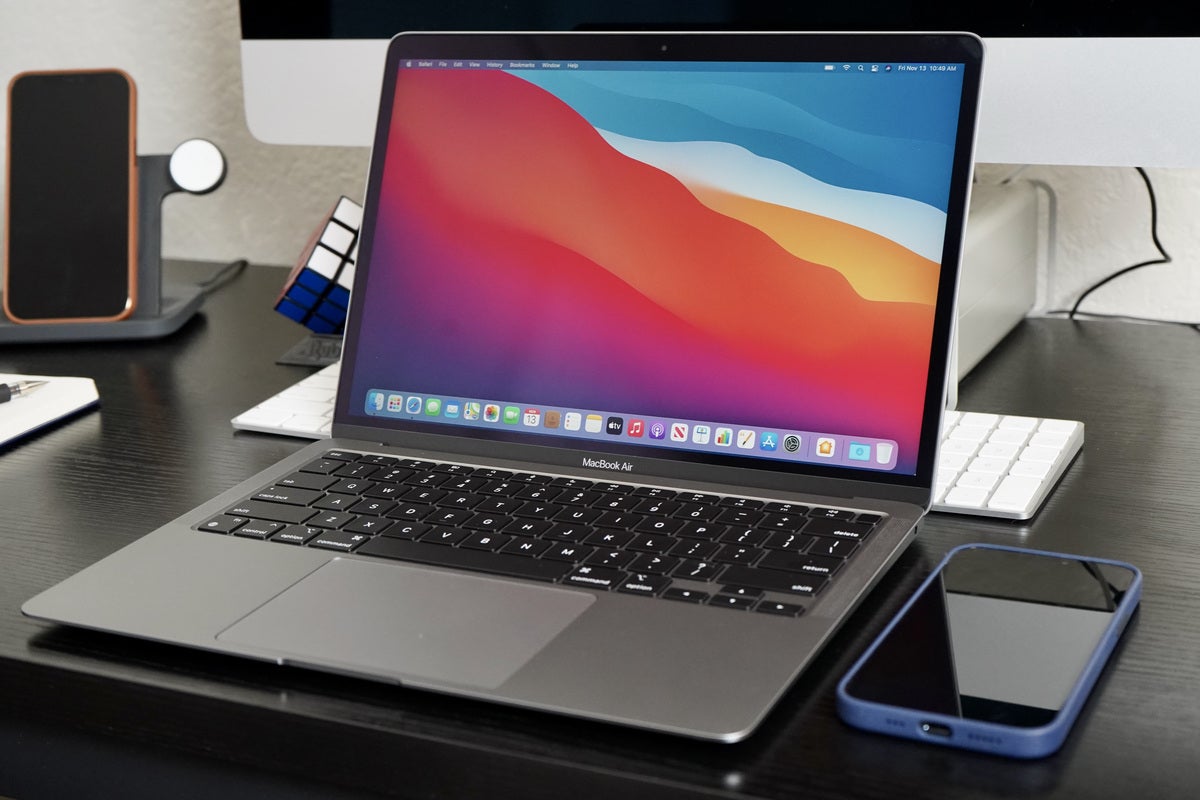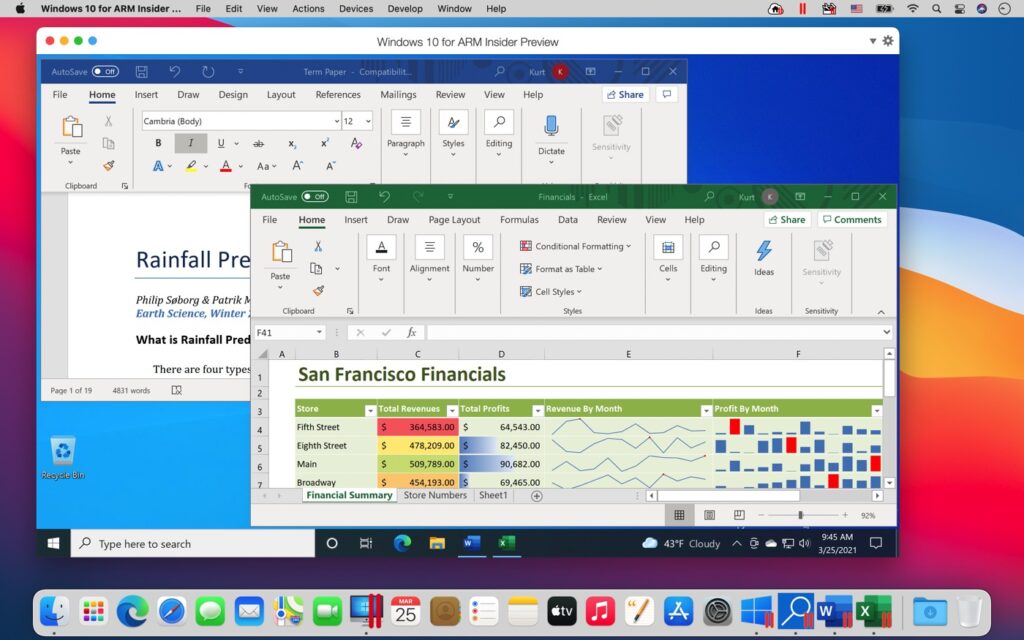
Apr 14, 2021 Tested with a pre-release version of Parallels Desktop 16.5 on MacBook Pro17,1 with Apple M1 chip and 16GB RAM versus MacBook Pro 15,1 with Intel Core i9-8950HK, 16GB RAM and Radeon Pro 555X GPU. The performance will vary based on usage, system configuration and other factors. Apple M1's integrated GPU appears to be 60% faster than AMD's Radeon Pro 555X discrete graphics processor in DirectX 11 applications when running Windows using the Parallels Desktop 16.5.
Seamless Use Windows side-by-side with macOS (no restarting required) on your MacBook, MacBook Pro, iMac, iMac Pro, Mac mini or Mac Pro. Share files and folders, copy and paste images and text & drag and drop files between Mac and Windows applications. Easy Set-Up Parallels Desktop automatically detects what you need to get started so you are up and going within minutes!
A few months ago, Parallels previewed its Parallels Desktop for Mac virtualization software on M1 Macs, and on Wednesday, the company annnounced that Parallels Desktop 16.5 for Mac —which brings. Parallels has officially launched its Technical Preview Program for users of M1 Macs that want to run Windows 10. In this video, we installed the both the Pa.
For years, people have speculated about the ability to run iOS apps on the Mac. This speculation was caused by the increasing similarity in the user experiences across the Mac, the iPhone and the iPad, and by Apple’s continuing tech demos showing their work on this capability.
Well, that day has finally arrived. Parallels® just released a new version of the Parallels® Access iOS client that can also be run on an M1 Mac.
I will admit that I was never really that interested in running an iOS app on my Mac, but I now see that I was wrong. This is pretty neat! In addition to Parallels Access, I installed a few other iOS apps on my Mac, among them, HBO Max. In general, a dedicated, special built app will almost always be better than using a webpage with similar functionality. And that is true for Parallels Access and true for HBO Max.
How to install an iOS app on an M1 Mac

The process of finding iOS apps that you want to download and install on an M1 Mac is a bit obtuse right now. (Figure 1). You use the App Store, but to find the iOS apps, you must first go to your account by clicking on your name in the main App Store window, and then use the selector buttons “Mac Apps” or “iPhone & iPad Apps” and choose “iPhone & iPad Apps”. Then you can search for the iOS app you want, for example “Parallels Access”. Hopefully, this will be easier and less circuitous in the future.

If you can’t find an iOS app that you know exists, this may be because the developer has marked the app as not downloadable on a Mac. This is often because the developer has not yet tested the iOS app on the Mac.

Running the Parallels Access iOS client on a Mac
Running the Parallels Access iOS client on a Mac looks just like using it on an iPad (Figure 2).
In this figure you can see that I have seven remote computers set up in Parallels Access: three MacBook Pros, two 27˝ iMac computers, one 21˝ iMac running macOS Catalina, and a really old ThinkPad running Windows 7. I can access any of them from the Parallels Access client on my iPad or on my M1 MacBook Pro. (Of course, I can also access these remote computers from any computer with a modern browser, but that is not the focus of this post.) Most importantly, the experiences on the M1 Mac and the iPad are nearly identical. The Mac has no touch screen, and the iPad has no mouse, but aside from these differences, Parallels Access is the same on both platforms.
Video 1 shows some of the Parallels Access functionality from the iOS client running on the M1 MacBook Pro. You can see the Remote Assistance feature added to Parallels Access last summer is available in Parallels Access when you run it on the M1 Mac.
I am also happy to report that the amusing “bug” that is present in almost every remote access application is present in Parallels Access on the M1 Mac: the ability to recursively access the very computer you are running the application from. You can see the result of this in Figure 3.
If you have an M1 Mac, let us know in the comments what iOS apps you have installed on it.
Parallels Access terminology check
Parallels Access is composed of two pieces of software: The Parallels Access client, which is installed on your phone or tablet, and the Parallels Access agent, which is installed on your Mac and PC. These two pieces of software work together to deliver remote access to your Mac and PC. You may have heard that:
The latest version of Parallels Access is a universal binary, meaning it contains the necessary code to run at full speed on either Mac with Intel processor or Mac with the Apple M1 chip.
This is true, but at the time that this was written, the only part of Parallels Access that ran on the Mac was the agent, so saying that the agent is now a universal binary is unnecessary. Well, the world has changed. Since Parallels Access can now run on the Mac—actually only on a Mac with an M1 chip—I would re-word that earlier statement to become:
The latest version of the Parallels Access agent is a universal binary, meaning it contains the necessary code to run at full speed on either Mac with Intel processor or Mac with the Apple M1 chip.
Apple’s “one more thing” event on November 10, 2020, revealed the first Mac computers powered by the Apple M1 chip.
Parallels is excited to see the performance, power efficiency, and virtualization features that are brought to the Mac with the Apple M1 chip. The transition to Mac with the M1 chip should be smooth for most Mac applications, thanks to Rosetta technology. Fortunately, Parallels Access™, Parallels® Toolbox, and Parallels® Client software worked smoothly as universal binaries even before Parallels rebuilt them. However, virtual machines are an exception and Parallels engineers proactively implemented native virtualization support for Mac computers with the M1 chip. This enables our users to enjoy the best Windows-on-Mac experience ever.
Learn more about the new version in this blog post.
When Apple Silicon Mac was first announced during the keynote at WWDC on June 22 of this year, Apple demoed a Parallels Desktop for Mac prototype running a Linux virtual machine flawlessly on Apple Silicon. Since WWDC, the new version of Parallels Desktop, which runs on Mac with the Apple M1 chip, has made tremendous progress. We switched Parallels Desktop to universal binary and optimized its virtualization code; Apple M1 Mac computers and macOS Big Sur became available, and Microsoft announced and then introduced support for x86_64 applications in Windows on ARM Insider Preview.
As our customers know, Parallels cares deeply about the quality of our software products and the experience they provide. With macOS Big Sur and the new Mac with Apple M1 chip available, we continue to conduct more extensive evaluations, both in our lab and with your help via the Parallels Technical Preview Program. More than 100,000 M1 Mac users tested the Technical Preview of Parallels Desktop 16 for M1 Mac and ran Microsoft’s Windows 10 on ARM Insider Preview, as well as tens of thousands of different Intel-based Windows applications—including Microsoft Office for Windows, Microsoft Visual Studio, SQL Server, Microsoft PowerBI, and MetaTrader.
Parallels On M1 Macbook
We received enthusiastic feedback about the remarkable performance of both the Technical Preview of Parallels Desktop 16 for M1 Mac and Windows 10 on ARM Insider Preview as well as x86 applications and the games inside it, including Rocket League, Among Us, Roblox, The Elder Scrolls V: Skyrim, Sam & Max Save the World, and many others. Testers loved Parallels Desktop’s easy to use features, and seamless integration of Windows and its applications with macOS Big Sur, which increased their productivity.
Macbook Pro M1 Parallels Desktop Review
On April 14th 2021, the new update for Parallels Desktop 16 for Mac was released and now features support for both Mac computers with Intel processor as well as Mac computers with Apple M1 chip.
